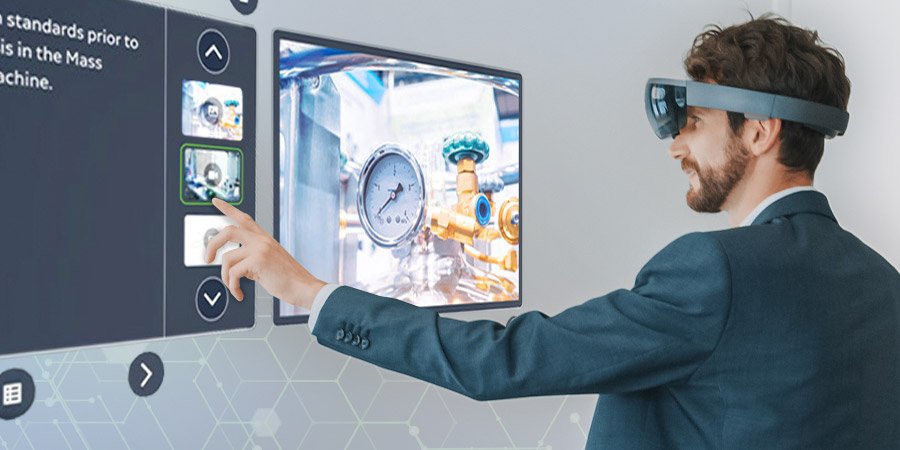Metaverse Augmented Reality: How Does It Function? Many people became excited about the metaverse after Facebook’s 2021 switch to Meta. Shortly after its introduction, “metaverse” soared to the top of Google’s search results. The significance of many components for the metaverse development is reflected in the discussions surrounding augmented reality in the metaverse. Two immersive technologies that allow you to access the metaverse are augmented reality and virtual reality.
It offers a substitute for physical reality by allowing users to interact with various virtual settings using digital avatars. The versatility of augmented reality has contributed to its rising profile. By 2024, experts anticipate that over 1.7 billion augmented reality gadgets will be in use around the globe. In what ways can augmented reality impact the metaverse? Examining the many applications of augmented reality in the metaverse is essential.
Definition of Augmented Reality
When technology is utilized to enhance reality, it is called Augmented Reality. Augmented reality can potentially increase users’ perception of the natural world by incorporating digital features that may be interacted with. Based on our knowledge of how AR works, we might imagine that AR apps may provide visual and audio data within existing ecosystems. The majority of popular augmented reality applications should run smoothly on mobile devices. With the help of augmented reality apps, users could enhance their interactions with the real world.
Augmented reality can potentially enhance the natural environment by superimposing various digital elements on top of it. To further enhance the immersive metaverse experiences, the metaverse augmented reality equation could make use of digital overlays. Using augmented reality (AR), some examples of digital overlays are,
- Variation of colours depending on changes in situations.
- Addition of labels.
- Inserting real-time directions with navigation apps.
- Modifying user appearance or the environment by utilizing filters on Instagram and Snapchat.
- Superimposition of 3D models, images, and other digital information on real-world objects and surroundings.
In the metaverse, augmented reality is the perfect complement to virtual reality since it gives a more accurate picture of the real world. You will require specific equipment to use augmented reality features in the metaverse, like a headset or glasses. Interestingly, mixed reality is a feature that specific, more advanced versions of these glasses enable, which allows users to interact with virtual objects.
Consider searching for all product information with a single glance while wearing augmented reality glasses. Metaverse shopping with augmented reality glasses allows you to see how different outfits would appear on you. With these glasses, you could virtually try on clothes before buying them online, ushering in a new era of streamlined shopping.
Variants of Augmented Reality
Based on what we know about AR’s core implications, it could completely change how we interact with digital content. Nevertheless, you can learn about AR use cases and their value by delving into several versions. To assist you in deciding how to build use cases for augmented reality in the metaverse, we’ve compiled a list of some of the most prominent AR versions.
-
Marker Augmented Reality
The traditional kind of augmented reality uses marker-based technologies. In this version, gadgets could take pictures, process them using image recognition and marker tracking, and then figure out where virtual things would look best to be placed. The augmented reality system uses the location and orientation of tagged items for accurate identification, with the photos already present in the database. Instagram and Snapchat filters are the most prominent examples of augmented reality that relies on markers. Using markers, users may find the sweet spot for applying filters to their real-time camera footage.
-
Markerless Augmented Reality
Markerless augmented reality systems are the following kind. Augmented reality without markers does not use pre-programmed images or objects to aid identification. You can find efficient ways to employ markerless augmented reality by answering the following questions: “What are the use cases of AI in the metaverse?”
Businesses, events, and navigation apps can all benefit from it. Markerless augmented reality systems can determine the user’s search parameters based on location. Augmented reality without markers uses sensors like gyroscopes, accelerometers, and global positioning systems. The various forms of AR without markers are presented here.
- Location-based Augmented Reality
- Superimposition-based Augmented Reality
- Projection-based Augmented Reality
- Contour-based Augmented Reality
Working Mechanisms for Augmented Reality
The definition of augmented reality provides a quick overview of its operation. It generates overlays of virtual objects onto actual items, people, and environments. This allowed them to create virtual environments seamlessly, blending the digital and physical realms. To understand how augmented reality (AR) contributes to the metaverse, it is helpful to understand its key components first.
-
Sensors and Cameras
Hardware for augmented reality relies heavily on sensors to provide the AR algorithm with information about its physical environment. A person or object’s precise position and orientation could be better ascertained using augmented reality applications. Several technologies, including gyroscopes, cameras, GPS, and accelerators, could be used in augmented reality applications. It can then facilitate incorporating digital features when applied to the real world.
-
Algorithms
The working mechanics of augmented reality also reveal that AR systems use machine learning to create a map of the physical environment. Also, the AI algorithms that determine where virtual items are should rely heavily on image processing techniques. Machine learning algorithms are a must-have to guarantee that augmented reality systems can work as intended.
-
Output Devices
Output devices are another notable addition to the components of augmented reality. The devices could help users in viewing virtual objects. One of the most prominent examples of an output device for AR systems is the head-mounted display or headset. Individuals also use their phones to explore the functionalities of augmented reality.
Applications of AR in the Metaverse
The use cases are the next crucial point to remember when grasping the relevance of metaverse augmented reality. One of the most essential platforms for digital experiences will be the opposing. So, the metaverse is a great place to imagine digital user experiences for many industries. Here are some ways augmented reality is used in various metaverse industries.
-
Architecture
Architectural use cases could be better supported by visualization. Using augmented reality, you may be able to find the perfect pieces of furniture to complement your home’s decor. Wall colours and hangings could be better visualized with the help of Augmented Reality. Plus, it lets you picture how various parts of your home’s design will come together.
-
Healthcare
Questions such as “What are the use cases of AI in metaverse?” also highlight the intersection with healthcare. Augmented reality has grown in significance within medical education and training. Accurate visualization of the human anatomy can be aided by it for academics and healthcare professionals.
Furthermore, it provides the option to scan MRIs and other scan images from different angles. For example, by observing a surgeon perform a real-life operation, students can gain valuable insight into the steps involved in a surgical procedure.
-
Tourism
Due to its use in the metaverse, there would be new uses for augmented reality in the hotel and tourist industries. In the metaverse, users can use augmented reality to get more information about the places they’re interested in visiting. Such augmented reality applications are like having a personal guide show you the sights in a foreign country. A new, revolutionary experience in tourism may be possible with the use of augmented reality.
-
Retail Market
The impact of augmented reality on improving the metaverse would also point to the use cases for the retail market. Users could view 3D representations of different products before purchasing them. In a way, AR could help resolve consumer apprehensions during virtual shopping. For instance, you could determine your appearance in a specific dress before purchasing it.
-
Education
The educational sector could likewise benefit from the use cases of augmented reality in the metaverse. Students in today’s classrooms can benefit significantly from augmented reality’s ability to create immersive, interactive learning environments incorporating virtual components. These AR in metaverse examples demonstrate how it has the potential to pique students’ interest in the subject matter and keep them engaged throughout their education. Students are more engaged when seeing the planets in a virtual solar system.
How is Augmented Reality Different from Virtual Reality?
The fundamental concepts related to applications of AR in the metaverse also invite curiosity regarding the impact of virtual reality. How are the applications of virtual reality in the metaverse different from AR? As the name implies, virtual reality is complete, while AR utilizes real-world surroundings. Both technologies are crucial for developing the metaverse and its interactions. Virtual reality offers experiences that can help replace physical surroundings with simulated environments.
On the other hand, augmented reality denotes the physical reality you witness around you. However, it has an additional layer of information. The most important highlight of AR is that any individual can experience augmented reality through smartphones. Augmented reality focuses on magnifying the value of user experiences in the metaverse.
Importance of Augmented Reality for Metaverse
The various applications of AR in the metaverse demonstrate the potential advantages of AR in changing the world. Though there may be more benefits to combining augmented reality with metaverse, you can use them alone. To further understand how the metaverse’s augmented reality features work, it’s helpful to consider it a digital landscape where users can design their unique virtual environments. Please get to know the metaverse and its interconnected system of virtual worlds that can be accessed through virtual reality goggles and headsets. In what ways does AR impact the metaverse?
You can see the physical world in a new light with the help of the metaverse. The world, however, remained unchanged. Conversely, augmented reality can potentially enrich our environments with new dimensions. To better comprehend the area in question, you can, for instance, use GPS data, texts, or pictures. Better depth perception is another benefit of the elements’ spatial representation.
Above all else, metaverse augmented reality tricks your brain into thinking the virtual components are physically present. This might make the physical world more engaging and exciting for metaverse users. Curiously, Mark Zuckerberg has also said that AR is critical to making the “embodied internet” a reality.
Future of Augmented Reality for the Metaverse
One way that AI is shaping the metaverse is through augmented reality systems that use machine learning algorithms. Another thing that stands out is the significant role that augmented reality plays in making the metaverse a reality. Answers to the question “What are the use cases of AI in the metaverse?” and the metaverse’s place in the current digital renaissance highlight the value of a metaverse with additional features. The ever-increasing demand for augmented reality goggles, gadgets, and gaming aids will determine the fate of augmented reality in the metaverse. Users could enjoy the next generation of 3D experiences if augmented reality technologies were widely used.
Smartphones are the most convenient way for users to learn about augmented reality applications. In addition, augmented reality’s practicality in several fields can potentially increase the use of AR in the metaverse.
Bottom line
Regarding the metaverse, augmented reality is all about how it can change things. Integrating the metaverse into our everyday lives is made more accessible by this. The goal of the metaverse, which is to connect the actual and virtual worlds, can be partially realized through augmented reality.
Education, healthcare, and retail fields are reaping augmented reality’s benefits. Unfortunately, augmented reality has not yet achieved widespread use. Concurrently, augmented reality’s app availability bodes well for the technology’s uptake. Get a better understanding of augmented reality and its inner workings to discover how it enhances the metaverse.







